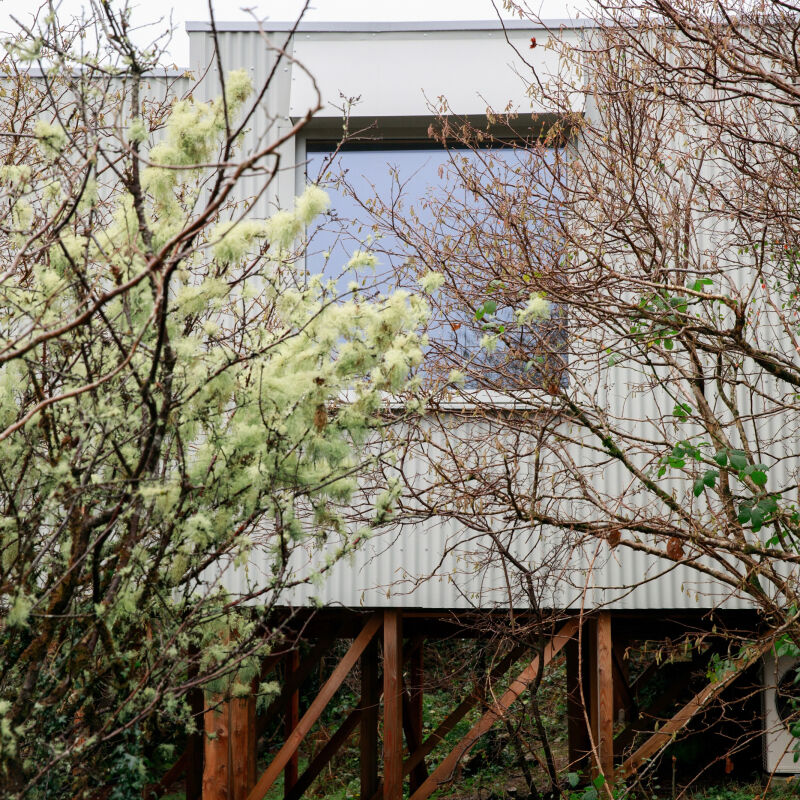Noise annoys. And it’s unavoidable: my own thoughts right now are being drowned out by the whine of a leaf blower that ought to be illegal. How to muffle the din? Of late, we’ve been heartened to discover acoustic tile that’s not only presentable but made of natural, biodegradable materials.
Archisonic of Switzerland, for instance, uses felt (composed of plastic water bottles) and cotton that’s fully recyclable to create ceiling baffles and wall panels. The UK’s Wood Veneer Hub produces Acoustic Slat Panels that look like pale wood paneling and have sound-absorbing capabilities. And Baux of Stockholm, spotlighted here, wins the beauty prize for its geometric and colorful noise-canceling offerings composed entirely of renewable materials. It’s newly available in the US. Come take a look.
Photography courtesy of Baux (@bauxdesign).

Several sustainability minded Swedish designers teamed up to launch Baux including the founding partners of Form Us With Love and the founder of Hem Design Studio.





The company typically sells to architects and designs but not exclusively. For more information, including pricing, sample requests, and installation details, go to Baux.
Frequently asked questions
What is eco-friendly acoustic paneling?
Eco-friendly acoustic paneling refers to sound-absorbing panels that are designed to reduce noise pollution in indoor spaces. These panels are made using sustainable and biodegradable materials, making them environmentally friendly.
How does eco-friendly acoustic paneling work?
Eco-friendly acoustic paneling works by absorbing sound waves and reducing their reflection, thus minimizing echo and reverberation in a room. The panels are made from materials that have high sound absorption properties, enhancing the acoustics of the space.
What are the benefits of using eco-friendly acoustic paneling?
Using eco-friendly acoustic paneling offers several benefits, including improved sound quality, reduced noise levels, increased privacy, and enhanced aesthetics. Additionally, these panels contribute to a healthier environment by being biodegradable and made from sustainable materials.
Are there any design options available for eco-friendly acoustic paneling?
Yes, there are various design options available for eco-friendly acoustic paneling. These panels come in a range of colors, patterns, and textures, allowing for customization to suit different interior design styles and preferences.
How long do eco-friendly acoustic panels last?
The lifespan of eco-friendly acoustic panels depends on the specific brand and quality of the product. However, with proper care and maintenance, these panels can last for many years, providing long-term noise reduction and environmental benefits.
How do I install eco-friendly acoustic paneling?
The installation process for eco-friendly acoustic paneling may vary depending on the brand and type of panels you choose. Generally, these panels can be easily mounted on walls or ceilings using adhesive, screws, or a combination of both. It is advisable to follow the manufacturer's instructions for proper installation.
Is eco-friendly acoustic paneling suitable for both residential and commercial spaces?
Yes, eco-friendly acoustic paneling is suitable for both residential and commercial spaces. Whether it's a home, office, restaurant, or any other indoor environment, these panels can effectively improve the acoustics and create a more pleasant and comfortable atmosphere.
Can eco-friendly acoustic paneling be recycled?
The recyclability of eco-friendly acoustic paneling depends on the specific materials used. While some panels are fully biodegradable and can be composted or recycled, others may require specialized recycling processes. It is recommended to check with the manufacturer or supplier for information on the disposal and recycling options for the specific product.





Have a Question or Comment About This Post?
Join the conversation